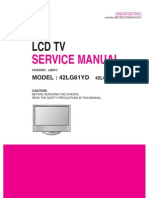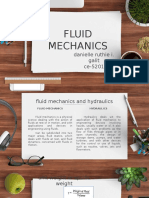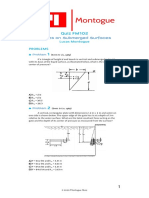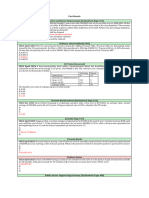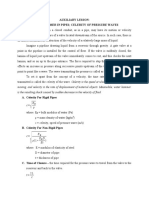FLUID-MECHANICS
Uploaded by
Geraldine ManaloFLUID-MECHANICS
Uploaded by
Geraldine ManaloFLUID MECHANICS Kinematic Viscosity
PROPERTIES OF FLUID ν= (m2/s or stoke)
Where:
Unit Weight or Specific Weight 1 stoke = 1 cm2/s = 0.0001m2/s
1 centiStoke (cSt) = 10-6 m2/s
weight of fluid
γ=
volume
For water, γ = 9810 N/m3 = 62.4 lb/ft3 Pressure inside a droplet of liquid
4
p=
Mass Density or Density d
Where:
σ = surface tension in N/m
mass of fluid
ρ= d = diameter of the droplet in meter
volume p = gage pressure in Pascals
For water, ρ = 1000 kg/m3
CAPILLARITY
Density of Gases
p
ρ=
RT
Where:
p= absolute pressure of gas in kPa
R=gas constant in Joule
T=absolute temperature in degree Kelvin
(°K = °C + 273)
(Rankie = °F +460)
4 cos
h=
d
Specific Volume
Use θ =140° for mercury on clean glass
1
Vs =
For complete wetting, as with water on clean
glass, the angle θ is 0° Hence the formula
becomes:
Specific Gravity
4
h=
fluid d
S= = fluid
water water Where:
h = capillary rise or depression
γ = unit weight
d = diameter of the tube
VISCOSITY σ = surface tension
Dynamic or Absolute Viscosity
Bulk Modulus of Elasticity
μ= dp' p
dV / dy E= = (lb/in2 or Pa)
- dv / v v
(Pascal-second or Poise)
v
Where:
Where:
1 poise = 1 dyne-sec / cm2 = 0.1 Pa-s
dp’ = change in pressure
1 centiPoise (cP) = 0.001 Pa-s
dv = change in volume
v = volume
COMPRE Prepared by: Galit, Danielle Ruthie I. CE - 5201
COMPRESSION OF GASES Pressure below layers of different
liquids
For a perfect gas
pvn = p1v1n = constant
pv = p1v1
p1v1k= p2v2k
Boyle’s Law (perfect gas)
k
p= or pV = k
V
p1v1= p2v2 Pressure Head
Combined Charle’s and Boyle’s
h=
Law (perfect gas)
p1v1 pv Atmospheric Pressure
= 2 2
T1 T2
PRESSURE DISTURBANCE
EB
c= (m/s or ft/s)
Where: Absolute Pres ure
c = celerity or velocity of pressure wave in m.s or ft/s s
EB = bulk modulus of elasticity of the fluid in Pa or pabs = pgage + patm
lb/ft2
To convert pressure head of liquid A to
liquid B
UNIT PRESSURE
Variations in Pressure
To convert pressure head of any liquid
to water
hwater = hliquid x Sliquid
TOTAL HYDROSTATIC PRESSURE
p2 - p1 = γ h Total Pressure on Plane Surface
p=γh
COMPRE Prepared by: Galit, Danielle Ruthie I. CE - 5201
Steps of Solution:
F = pcg x A or F = γ h A I. Consider 1 unit (1 m) length of dam
II. Determine all the forces acting:
Ig
e=
AY
h
Y=
sin
Where:
pcg = pressure at the centroid of the plane
Ig = centroidal moment of inertia of the
plane
A = area of the plane surface
θ = angle that the plane makes with the
horizontal
Total Pressure on Curved Surface
FH = pcg A
FV = γ VABCD
F= FH2 FV2 Factor of Safety against Sliding
FV
tan θ = Ry
FH FSS =
Rx
Where:
FH= total force acting on the vertical
projection of the curved surface Factor of Safety against Overturning
FV= weight of imaginary or real fluid
directly above the curved surface RM
FSO =
DAMS OM
FOUNDATION PRESSURE (SOIL
PRESSURE)
Eccentricity
B
e= - x
2
For e ≤ B/6
R y 6e
q=- 1
B B
Use (+) for the pressure at the toe
Use (-) for the pressure at the heel
For e B/6
2R y
q=
3x
COMPRE Prepared by: Galit, Danielle Ruthie I. CE - 5201
BUOYANCY
For homogeneous body floating on a
homogeneous liquid, the volume displaced is: vS
MBO =
VD sin
body
VD = Vbody
liquid RM or OM = W(x) = W (MG sin θ)
Sbody Where:
VD = Vbody v= volume of the wedge of immersion
Sliquid s= horizontal distance between the centroid of the
wedges
VD= volume displaced
θ= angle of tilting
STABILITY OF FLOATING BODY
If the body has the shape of a rectangular
parallelipiped
B2 tan 2
MBO = 1
12D 2
Where:
B= width; D= draft
Metacentric Height
MG = MBO ± GBO
Value of MBO in the Upright Position
(Initial Value)
I
MBO=
VD
Where:
I = moment of inertia of the body along the
waterline section
RELATIVE EQUILIBRIUM OF LIQUIDS
Horizontal Acceleration
a
tan θ =
g
COMPRE Prepared by: Galit, Danielle Ruthie I. CE - 5201
Inclined Acceleration Continuity Equation
Incompressible fluid
ah Q1 = Q2 = Q3
tan θ =
g av A1v1= A2v2 = A3v3
ah = a cos α; av = a sin α
Compressible fluid
Vertical Acceleration ρ1Q1 = ρ2Q2 = ρ3Q3
REYNOLDS’ NUMBER
vD vD
R= =
Where:
a v = mean velocity of flow, ms
p = γ h 1
g D = pipe diameter, m
μ = (mu) dynamic viscosity (Pa-s)
Use (+) for upward motion and (-) for downward ν = (nu) kinematic viscosity (m2/s)
ρ = density, kg/m3
motion
ROTATION ENERGY EQUATION
Total Energy of Flow
E = Kinetic Energy + Potential Energy
v2 p
E= Z
2g
Where:
v2
velocity head (KE)
2g
p
pressure head (PE)
Z elevation head (PE)
Volume of Paraboloid
Volume = 1/2 π r2 h BERNOULLI’S ENERGY THEOREM
FLUID FLOW AND PIPES
Flow Rate
Volume Flow Rate (Q) = Av
Mass Flow Rate (M) = ρ Q
Weight Flow Rate (W) = γ Q Where:
E1 = Total energy head at section 1
HA = head added (by the pump)
HE = head extracted (by turbine or any other
device)
HL = total head los
COMPRE Prepared by: Galit, Danielle Ruthie I. CE - 5201
SAMPLE PROBLEMS
1. A rectangular gate has a base width of 1m SOLUTION:
and altitude of 2.4m. The short side of the
gate is flushed with the water surface. Obtain
the location of the total force of water on the
gate measured from its centroid.
SOLUTION:
2. A spherical balloon 5. 8 in diameter is
filled with gas weighing 5 N/m3 . In standard
air weighing 12 N/m3 , evaluate the
maximum load, in N, excluding its own
weight, that the balloon can lift. N/m3
SOLUTION: 4. For the concrete gravity dam, B=4.20m,
b=0.60m, H=7m, and h=6m. Unit weight of
concrete is 24 kN/m3. Considering 1m length
of dam, calculate the total force exerted by the
water on the dam and the resisting moment.
SOLUTION:
3. An 8 hp pump is installed near the
reservoir container oil having as specific
gravity of 0.82. The rate of flow of the pipe is
0.014m3/s. The pressure heads at 1 and 2 are
-28 kPa and +290 kPa respectively. Compute
the head added and the efficiency of the
pump.
COMPRE Prepared by: Galit, Danielle Ruthie I. CE - 5201
5. A 12 mm thick steel with inside diameter 7. A rectangular tan of internal width of 5 m
of 600 mm conveys water under a head of 350 as shown in the figure, contains oil of specific
m. What is the tensile stress in the pipe wall gravity of 0.8 and water. If a 1000-N block is
in kN per meter? made to float in oil, what is the rise in water
surface in chamber B?
SOLUTION:
SOLUTION:
6. A stone weighs 5.2 N when immersed in
water and6 N when immersed in alcohol
having a specific gravity of 0.80. Unit weight
of water is 9.81 kN/m3. Determine the volume,
specific gravity and density of the stone.
SOLUTION:
8. An open cylindrical vessel 4m in diameter
and 6m high is two-thirds full of water. The
vessel is revolved about its own vertical axis
at constant angular speed. Calculate the
peripheral velocity at the top rim of the vessel
when the water starts to spill out.
SOLUTION:
COMPRE Prepared by: Galit, Danielle Ruthie I. CE - 5201
9. A certain fluid have a specific gravity of
1.25 flows through a150 mm diameter pipe
with mean velocity of 1.2 m/s. Determine the
flow rate, mass flow rate and weight flow
rate.
SOLUTION:
SOLUTION:
10. Water flows through a pipe that enlarge
from 154 mm diameter at A to 249 mm in
diameter at B which is 4.6 m above point A.
The pressure at points A and B are 70 kPa and
48.3 kPa, respectively. Determine the energy
at A and energy at B in Joule per kilogram.
SOLUTION:
12. An open cylindrical tank has a base
diameter of 1.2 meters contains 3.86 meters
deep of water. The tank is rotated about the its
vertical axis at 80 rpm. If angular velocity is
120 rpm, how much water is spilled?
SOLUTION:
11. A 1.5 m square tank contains water to a
depth of 2.6 m. A cubical block of wood 0.6m
on each side is made to float in water inside
the tank. The specific gravity of the wood is
0.5. What is the change in the total force
acting on the floor of the tank?
COMPRE Prepared by: Galit, Danielle Ruthie I. CE - 5201
13. Two vertical tanks are connected near the
bottom by a short tube having a cross
sectional area of 0.00625 m2, the cross
sectional areas of the tanks are 8 m2 and 2 m2
respectively. The tank contains water with the
water surface in the larger tank 4m above the
tube and in the smaller tank 1m above the
tube. Assume a constant discharge coefficient
of 0.072. Find the time for the water surfaces
in the two tanks to reach the same elevation.
SOLUTION:
SOLUTION:
14. Water flows on a straight 350 m pipe, 600
mm in diameter. The velocity of flow is 2.3
m/s. Pipe thickness is 18mm. Bulk modulus
of elasticity of water is 2.2 x 109 Pa. Modulus
of elasticity of pipe material is 1.4 x 1011 Pa.
What is the celerity of pressure wave?
SOLUTION:
15. Water flows from point 1 to point 2 at the
rate of 280 L/s in a 300-mm-diameter pipe.
The elevation of point 2 is 360 m. When the
gate valve near point 2 is closed, the
difference in pressure between point 2 and
point 1 is 80 kPa. When the valve is opened,
the difference in pressure between point 1 and
point 2 is 170 kPa. Determine the head lost
between points 1 and 2 when the valve is
opened and the length of pipe from points 1
and 2 assuming f=0.03.
COMPRE Prepared by: Galit, Danielle Ruthie I. CE - 5201
You might also like
- Second Quarter - Module 35: MathematicsNo ratings yetSecond Quarter - Module 35: Mathematics23 pages
- Service Manuals LG TV LCD 42LG61YD 42LG61YD Service ManualNo ratings yetService Manuals LG TV LCD 42LG61YD 42LG61YD Service Manual45 pages
- Question: 5 A. A Hollow Circular Cylinder Is Made of Cast Iron and Has AnNo ratings yetQuestion: 5 A. A Hollow Circular Cylinder Is Made of Cast Iron and Has An2 pages
- Toaz - Info Ce413 Tlo04 Weirs Solutionpdf PRNo ratings yetToaz - Info Ce413 Tlo04 Weirs Solutionpdf PR1 page
- Example. One-Way Slab Design. A Reinforced Concrete Slab Is Built Integrally With Its SupportsNo ratings yetExample. One-Way Slab Design. A Reinforced Concrete Slab Is Built Integrally With Its Supports1 page
- Permeability Test in The Field by Pumping From WellsNo ratings yetPermeability Test in The Field by Pumping From Wells16 pages
- Quiz FM102: Forces On Submerged SurfacesNo ratings yetQuiz FM102: Forces On Submerged Surfaces15 pages
- 1 Fluid-Properties Tutorial-Solution PDFNo ratings yet1 Fluid-Properties Tutorial-Solution PDF15 pages
- Hydrostatic Pressure: Ammarali@wrec - Uoqasim.edu - IqNo ratings yetHydrostatic Pressure: Ammarali@wrec - Uoqasim.edu - Iq13 pages
- (02-01) Geotechnical Engineering - Set 4No ratings yet(02-01) Geotechnical Engineering - Set 42 pages
- Republic of The Philippines: Battery - 2No ratings yetRepublic of The Philippines: Battery - 24 pages
- Statics of Rigid Bodies 1: Email AddressNo ratings yetStatics of Rigid Bodies 1: Email Address15 pages
- Potter Mechanics of Fluids Chap 2 SolManNo ratings yetPotter Mechanics of Fluids Chap 2 SolMan15 pages
- Review Module - Transportation EngineeringNo ratings yetReview Module - Transportation Engineering2 pages
- Hydrostatic Pressure On Surfaces: Engr. Angelica A. LosaresNo ratings yetHydrostatic Pressure On Surfaces: Engr. Angelica A. Losares26 pages
- Geotech - Topic 5 - Capillary Rise & Surface Tension - 14 Dec 2021No ratings yetGeotech - Topic 5 - Capillary Rise & Surface Tension - 14 Dec 20217 pages
- Close Reading From by Rodman Philbrick (Pg. 1 3) : Freak The MightyNo ratings yetClose Reading From by Rodman Philbrick (Pg. 1 3) : Freak The Mighty2 pages
- CPF India Private LTD - Compliance Mangement Proposal (June 26th 2024)No ratings yetCPF India Private LTD - Compliance Mangement Proposal (June 26th 2024)22 pages
- Warsash New Training Requirements Under Stcw10No ratings yetWarsash New Training Requirements Under Stcw106 pages
- Trends On Curriculum Contextualization: Thursday, July 01, 2021 Department of Education Region VIII Leyte 1100% (1)Trends On Curriculum Contextualization: Thursday, July 01, 2021 Department of Education Region VIII Leyte 134 pages
- International Islamic University Islamabad: Faculty of Management SciencesNo ratings yetInternational Islamic University Islamabad: Faculty of Management Sciences3 pages
- Distant Space Travel Better As Family AffairNo ratings yetDistant Space Travel Better As Family Affair1 page
- Image Cse No Model No Part No DescriptionNo ratings yetImage Cse No Model No Part No Description4 pages
- Service Manuals LG TV LCD 42LG61YD 42LG61YD Service ManualService Manuals LG TV LCD 42LG61YD 42LG61YD Service Manual
- Question: 5 A. A Hollow Circular Cylinder Is Made of Cast Iron and Has AnQuestion: 5 A. A Hollow Circular Cylinder Is Made of Cast Iron and Has An
- Example. One-Way Slab Design. A Reinforced Concrete Slab Is Built Integrally With Its SupportsExample. One-Way Slab Design. A Reinforced Concrete Slab Is Built Integrally With Its Supports
- Permeability Test in The Field by Pumping From WellsPermeability Test in The Field by Pumping From Wells
- Hydrostatic Pressure: Ammarali@wrec - Uoqasim.edu - IqHydrostatic Pressure: Ammarali@wrec - Uoqasim.edu - Iq
- Hydrostatic Pressure On Surfaces: Engr. Angelica A. LosaresHydrostatic Pressure On Surfaces: Engr. Angelica A. Losares
- Geotech - Topic 5 - Capillary Rise & Surface Tension - 14 Dec 2021Geotech - Topic 5 - Capillary Rise & Surface Tension - 14 Dec 2021
- Close Reading From by Rodman Philbrick (Pg. 1 3) : Freak The MightyClose Reading From by Rodman Philbrick (Pg. 1 3) : Freak The Mighty
- CPF India Private LTD - Compliance Mangement Proposal (June 26th 2024)CPF India Private LTD - Compliance Mangement Proposal (June 26th 2024)
- Trends On Curriculum Contextualization: Thursday, July 01, 2021 Department of Education Region VIII Leyte 1Trends On Curriculum Contextualization: Thursday, July 01, 2021 Department of Education Region VIII Leyte 1
- International Islamic University Islamabad: Faculty of Management SciencesInternational Islamic University Islamabad: Faculty of Management Sciences



